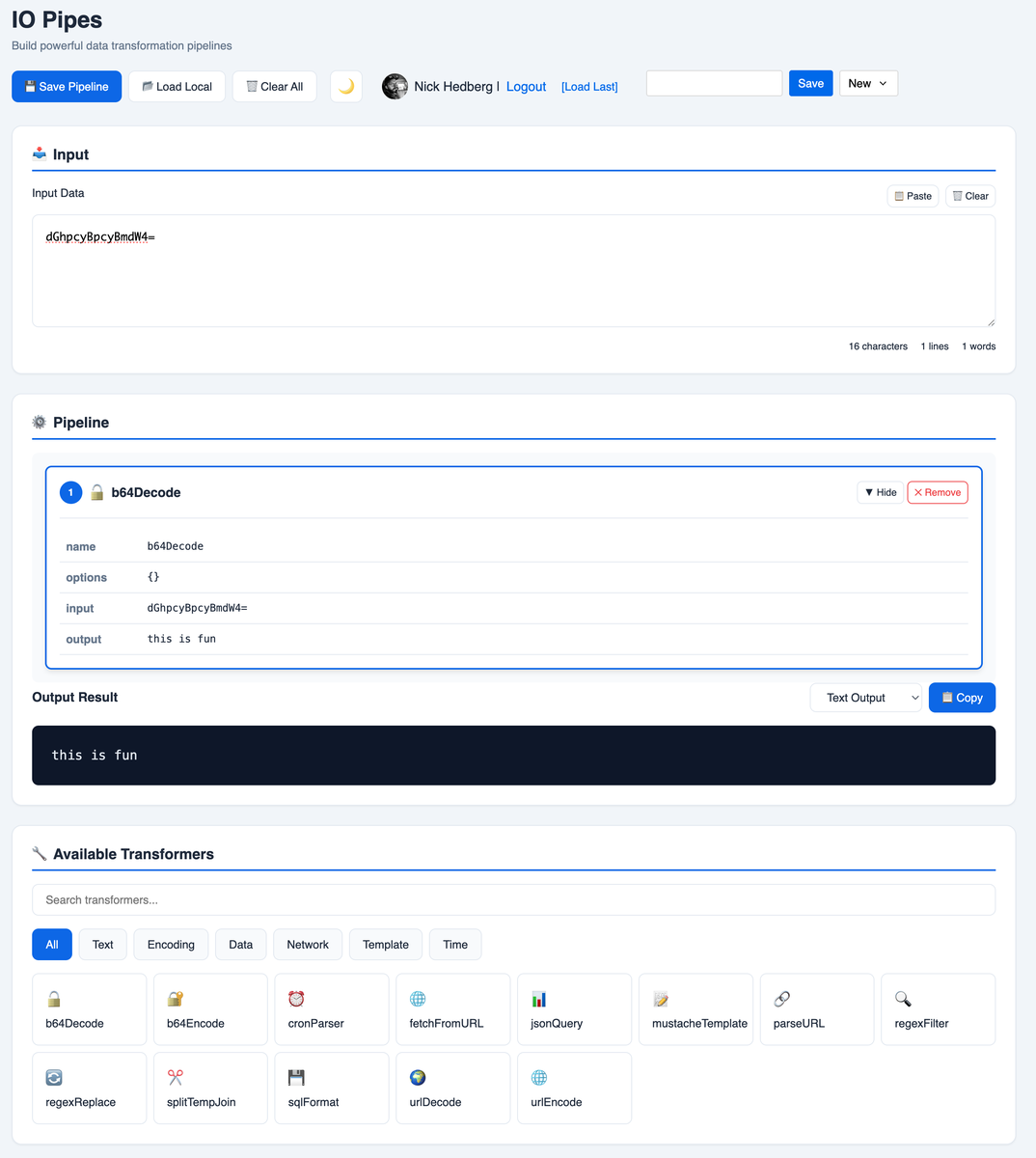IO Pipes: Data Transformation Workbench
A browser-based pipeline builder that lets me chain together regex filters, JSON queries, fetchers, and templating blocks, then save those pipelines for later reuse.
Overview
mono/tools/src/pages/pipeline/[[...id]].js renders the IO Pipes experience: a responsive layout with themed UI, Auth0 user controls, and three columns—Input, Pipeline, Available Transformers. Everything runs client-side, but pipelines can be persisted through API routes backed by MySQL, which makes it easy to share a link or revisit a previous flow.

Key Features
Guided Pipeline Builder
- Transformer Catalog:
TransformerSelectorexposes categories (Text, Data, Network, Template, Time) and icons for each transformer; search + tabs make it easy to find the right block. - Dynamic Options: Selecting a transformer attaches the matching React options component (
RegexFilterOptions,JSONQueryOptions,FetchFromURLOptions, etc.) so you can configure it inline without modal hopping. - Pipeline Flow UI:
TransformerPipelinerenders each block with step numbers, arrows, and detail toggles; you can inspect inputs/outputs, edit options, or remove steps without losing state.
Rich Input & Output Controls
- Smart Textarea:
TransformerInputauto-expands between 5–20 rows, exposes clipboard paste/clear shortcuts, and shows character/line/word counts for quick sanity checks. - Live Execution: Every edit re-runs the pipeline (sequentially awaiting async transformers), updating the final output pane with Text vs HTML rendering options.
- Clipboard Helpers: A copy button handles the output buffer with success feedback, so sharing results is one click away.
Persistence & Collaboration
- Auth-Aware Actions:
Usercomponent pulls Auth0 session info, exposes pipeline dropdowns (New, existing ids), and gates save/fork/delete actions. - Database Storage:
/tools/api/pipelinesPOST/PUT/DELETE routes upsert rows in thepipelinetable (JSON columns for transformers/settings) after verifying the user viaupsertUser. - Local Recovery:
usePipelinemirrors transformers intolocalStorage, giving you an offline recovery path even before you save to the database.
Technical Architecture
mono/tools/
├── src/pages/pipeline/[[...id]].js # Page shell + layout
├── src/hooks/usePipeline.js # Context (input, transformers, options)
├── src/components/ # UI building blocks
│ ├── TransformerInput.js
│ ├── TransformerPipeline.js
│ ├── TransformerSelector.js
│ ├── PipelineActions.js
│ ├── ThemeToggle.js
│ └── User.js
├── src/transformers/ # Individual transformer functions
└── src/pages/api/pipelines/ # Authenticated CRUD endpoints- Transformers as Modules: Each file in
src/transformersexports an asyncprocessfunction;usePipelineinjects these into pipeline steps so every transformer can maintain its own options schema. - MySQL Query Layer:
src/database/query.jshandles UUID conversions, JSON serialization, and enforces per-user access when updating or deleting a pipeline. - Theme + User Experience:
ThemeToggleswitches CSS variables, andUsershows avatar/login/logout links plus quick actions (Save, Fork, Delete, Load Last).
IO Pipes has become my go-to scratchpad for massaging logs, APIs, cron strings, and templated payloads without jumping into a local script each time.
